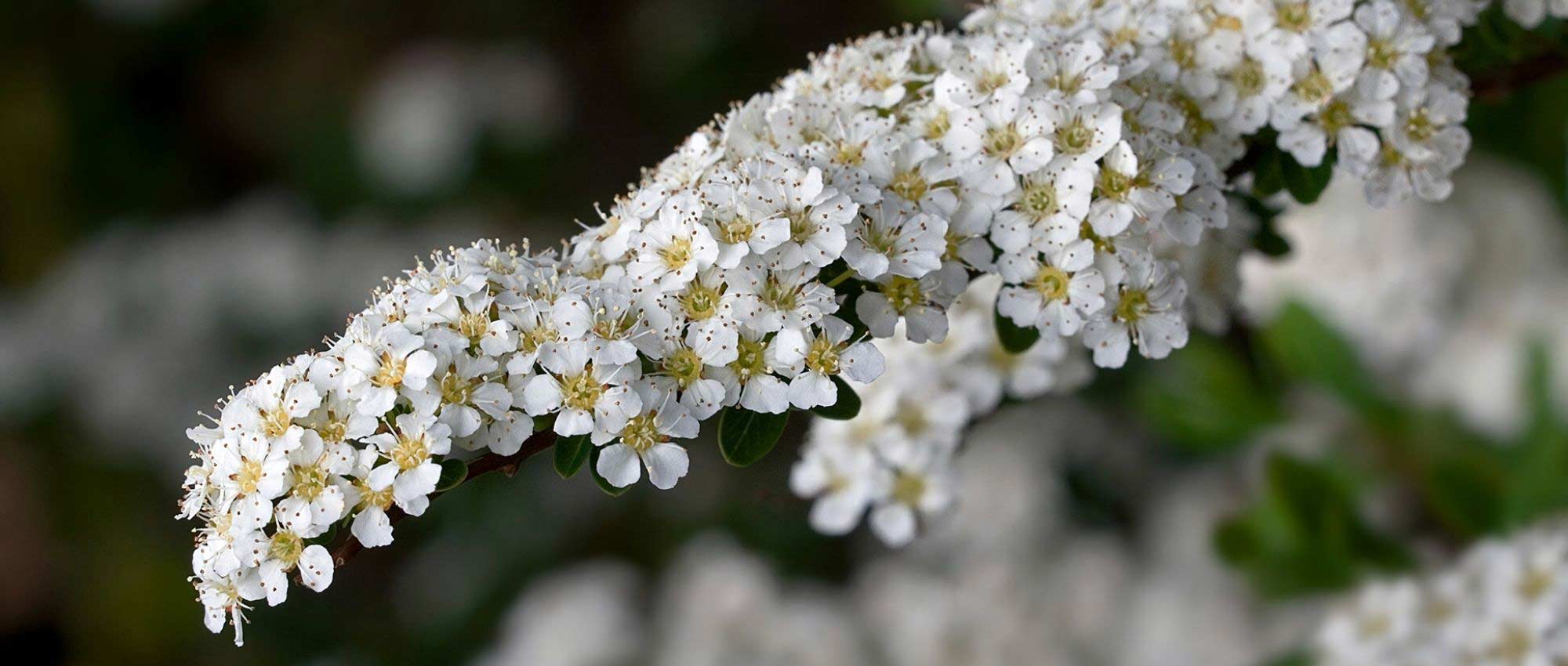
Best varieties of bushes with white flowers
Discover our selection!
Contents
White-flowering bushes are easy to incorporate into the garden and add plenty of light. They complement bushes pruned as topiary perfectly, creating a modern, streamlined atmosphere. They also fit well in romantic-style gardens, in company with pastel flowering such as soft pink, mauve or apricot. Also don’t hesitate to pair them with white-flowering perennials to create a true “white garden”, with a very soothing, airy atmosphere. White flowering can also be used to create contrasts, for example with plants with dark foliage, or to add lightness amid very bright, colourful flowering.
Discover the 12 most beautiful white-flowering bushes in this guide! And if you want more choice, see our full range of white-flowering bushes.
Also find Gwenaelle’s tips to design a white garden.
Cornus kousa 'Great Star'
Cornus kousa ‘Great Star’ is a dogwood that bears in spring, in May–June, superb white flowers. They are composed of four large bracts, broad and neatly tapered to a point, and measure about 10 cm in diameter. In September, decorative red fruits follow. They are edible but not particularly flavoursome. Its foliage also takes on beautiful red‑orange tones in autumn before falling. This is a vigorous, robust, hardy bush, fairly easy to grow. It grows slowly but reaches, at ripeness, up to 3 m in height and spread. Preferably plant in partial shade in fresh, well‑drained, humus‑bearing, lime‑free soil.
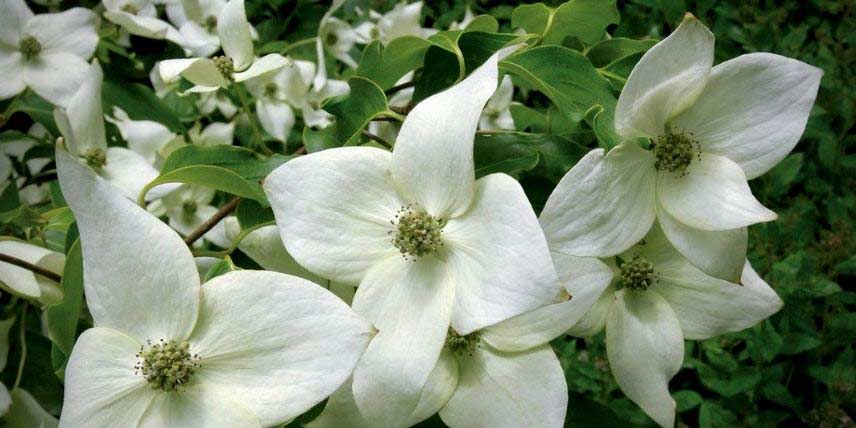
Philadelphus 'Belle Etoile'
Philadelphus ‘Belle Etoile’ is a mock-orange appreciated for its highly scented white flowering. It flowers in summer, in June–July, producing single flowers about 5 cm in diameter. They consist of four petals that reveal pale yellow stamens at the centre. The centre of the flower is also marked by rather subtle purplish tints. This variety of mock-orange is fairly compact, not exceeding 2 m in height and 1.1 m in spread. It bears arched branches that droop gracefully towards the ground. Its foliage is deciduous: the year’s leaves fall in autumn, and new ones appear in spring. It will thrive in full sun or partial shade, and is also perfect for integrating into an informal hedge.
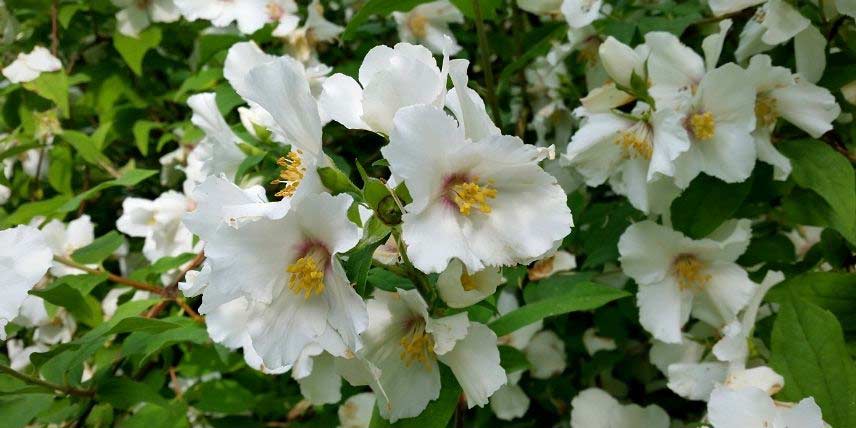
Discover other White garden inspiration
View all →Available in 0 sizes
Available in 1 sizes
Available in 1 sizes
Available in 1 sizes
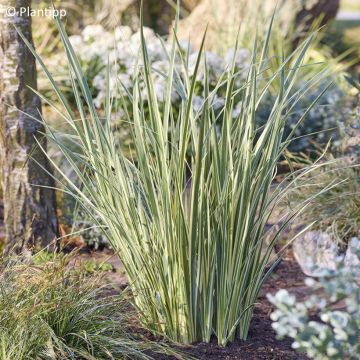
Available in 1 sizes
Available in 1 sizes
Available in 1 sizes
Available in 1 sizes
Available in 2 sizes
Available in 1 sizes
Deutzia gracilis
Deutzia gracilis is a small bush with a compact habit, not exceeding one metre in all directions. It flowers in spring, in May–June, then produces charming star-shaped, fragrant, pure white flowers made up of five petals. They generally attract many insects. It also bears attractive lanceolate, finely tapered foliage and is deciduous. Deutzia gracilis is easy to grow and grows quickly. It prefers relatively cool soil and grows in sun or partial shade, preferably in a sheltered spot away from wind. It combines very well with Philadelphus and Weigelias.
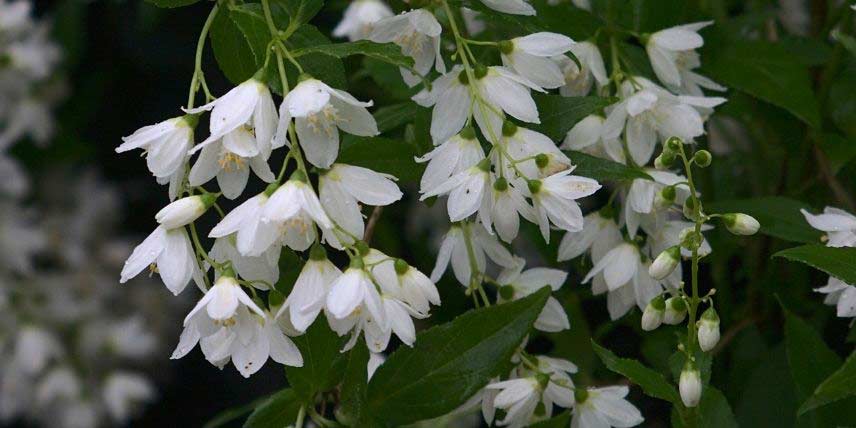
Exochorda x macrantha ‘The Bride’
Lovingly nicknamed pearl tree or bride tree, Exochorda x macrantha ‘The Bride’ bears in spring (April–May) a multitude of pure white flowers, semi-double, that can almost entirely cover the foliage! The flowers measure 2 to 3 cm in diameter and are borne on top of the branches. Its leaves, ovate and pale green, are deciduous and take on pretty yellow or golden hues in autumn before falling, with new ones appearing the following spring. Exochorda ‘The Bride’ reaches up to 2 m in height and 3 m in spread, so allow a little space when planting in the garden. It is robust but grows rather slowly. Plant in full sun in well-draining soil, not too calcareous.
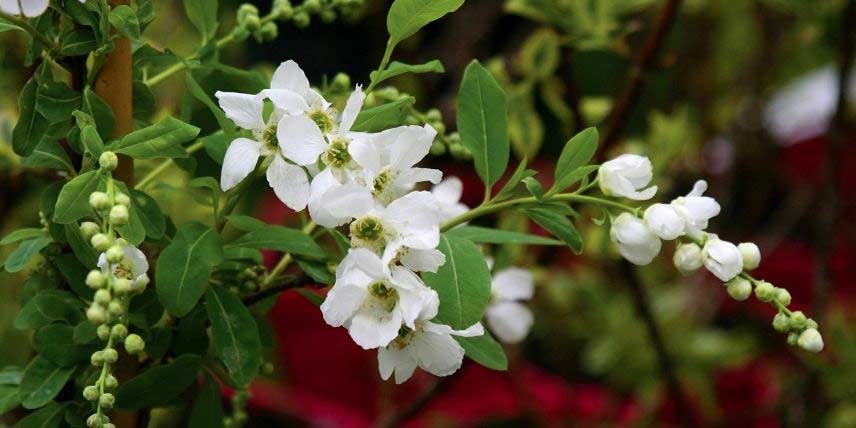
Choisya 'White Dazzler'
Also called Mexican orange, Choisya ‘White Dazzler’ is a bush with a compact, rounded habit, reaching up to 1.20 m in all directions. Its dense, well-ramified silhouette is admired. It has the advantage of being evergreen and bears very beautiful palmate foliage, divided into fine leaflets. In addition, it flowers twice a year, in late spring and early summer, and then becomes covered in white five-petalled flowers that release a pleasant orange blossom scent. It is hardy, resists drought, and also adapts to pot cultivation. It can easily be grown on a terrace or planted in open ground in a small garden! Plant in full sun in colder regions and northern France, and preferably in partial shade in the south. In dense shade, its habit is less compact and its flowering is less generous.
Discover also our guide: “Mexican orange, Choisya: Planting, pruning and maintenance”
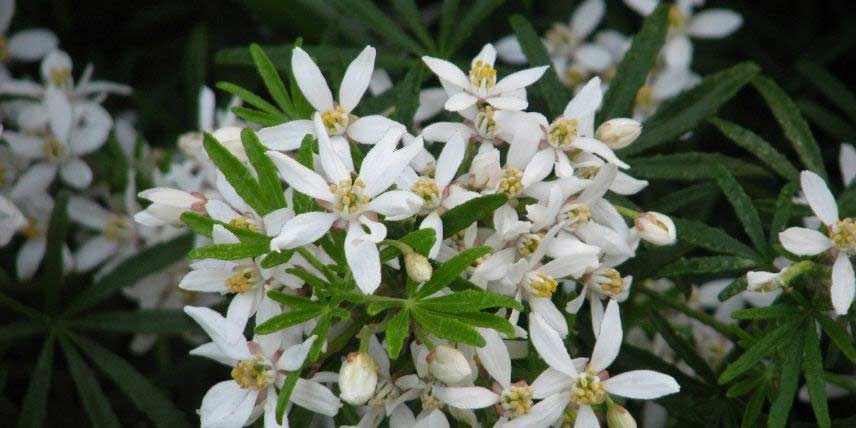
Hydrangea arborescens 'Annabelle'
Hydrangea ‘Annabelle’ produces an impressive flowering display from June to August, in the form of large spherical inflorescences measuring up to 30 cm in diameter. At first the inflorescences are rather pale green, before turning white as summer progresses. Flowering is so abundant that the flexible stems tend to bend under their weight! It thrives in sunny or partially shaded positions, and prefers fresh, humus-bearing soils with a rather neutral pH. This bush can reach up to 1.50 m in all directions. Its leaves are ovate, opposite, with a dentate margin, and deciduous. Once flowering has finished, you can leave the dried flowers on the plant; they will remain decorative through autumn and winter, taking on an ochre hue.
See also our advice sheet: ‘White hydrangeas: best varieties’
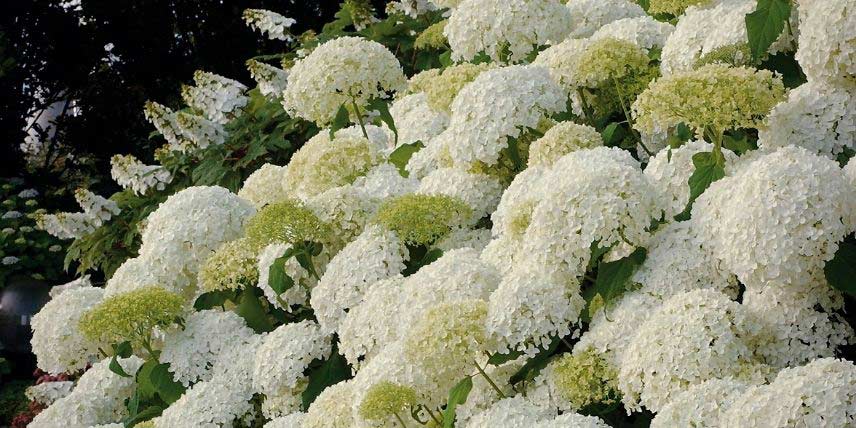
Magnolia stellata
Magnolia stellata is a very floriferous bush that, from late winter, in March–April, produces a multitude of star-shaped flowers. They appear before leaves, which makes flowering even more impressive, like a real spectacle! Flowers are solitary, measuring 8 to 10 cm in diameter, and they give off a light fragrance. It is a bush that grows fairly slowly, reaching 2 to 3 metres in height at ripeness. Perfectly hardy (down to −25 °C), Magnolia stellata thrives in sun or partial shade, in fresh, humus-bearing soil that is acidic or neutral, as it does not tolerate lime.
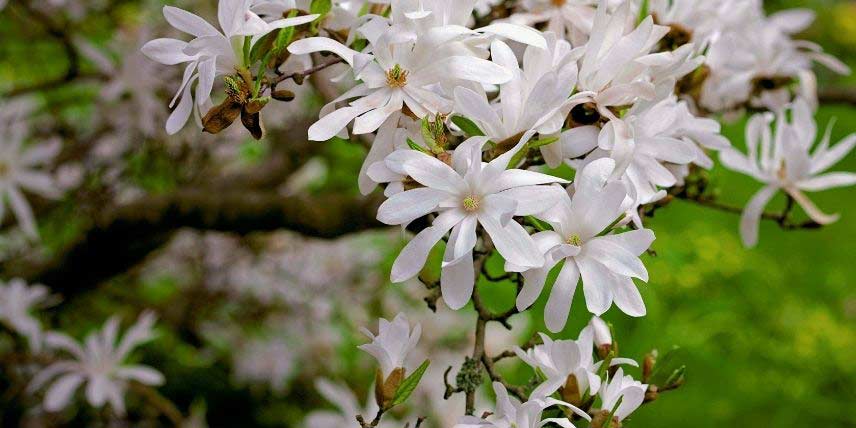
Prunus glandulosa 'Alba Plena'
Prunus glandulosa ‘Alba Plena’ is a splendid flowering cherry that produces in spring, in May, countless pure white, double flowers. Of small size, it does not exceed 1.50 m in height and spread, making it suitable for small gardens and for cultivation in a pot. Flowers measure about 4 cm in diameter, and their numerous petals give them a pretty rounded, pompom-like shape. They open before the leaves appear, which really showcases them. Leaves are ovate, slender and dentate, deciduous. It can be planted either as a solitary specimen, in a mixed border or in a hedge. Prefers sunny positions and fresh but well-drained soils.
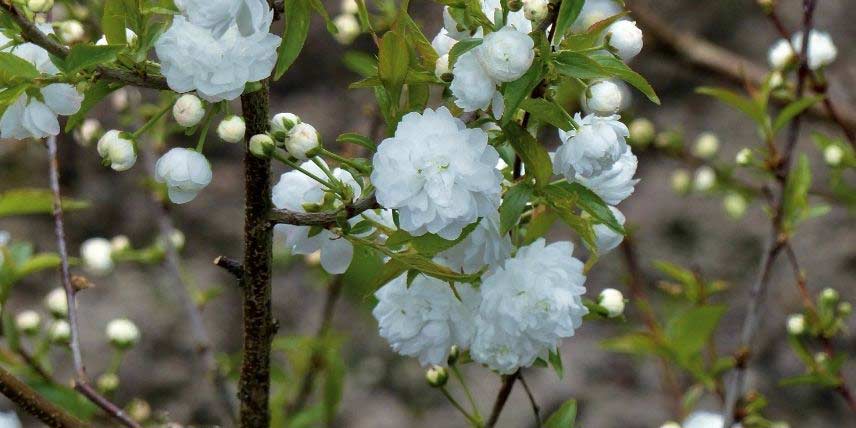
Viburnum plicatum 'Lanarth'
Viburnum plicatum ‘Lanarth’ is a viburnum notable for its distinctive spreading habit, with horizontal branches. Flowers appear in spring, around May, and are grouped in corymbs on top of the branches, producing a remarkable layered flowering. This bush grows fairly slowly and reaches up to 3 m in height and spread. It also has attractive dark green leaves with pronounced veins, about 10 cm long. Leaves turn a reddish-brown in autumn before falling. It thrives in sun or partial shade, in rich, moist soil.
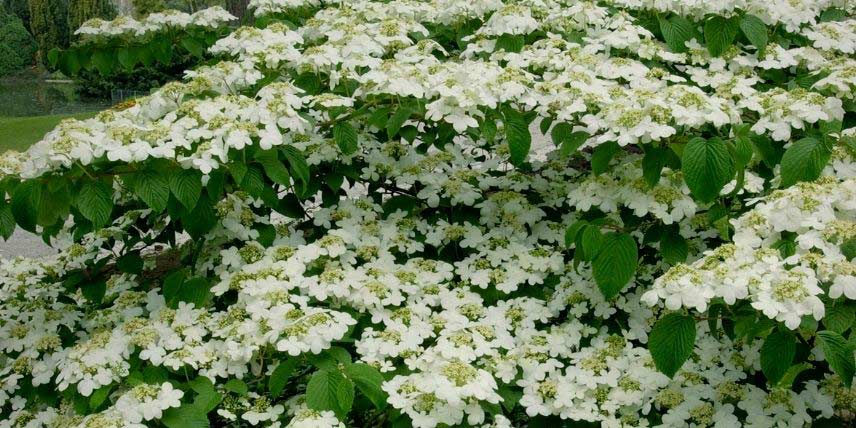
Spiraea arguta
Spiraea arguta is a small bush with a rounded silhouette, reaching about 1.50 m in all directions, even up to 2 m. It produces abundant spring flowering in April–May, lasting about three weeks. It is then literally covered with a multitude of small white flowers with five rounded petals, gathered in umbels. They open along the stems, which are arched and fall gracefully towards the ground! They are followed by fruits favoured by birds. As for leaves, they are small and finely dentate on the edge of the lamina. They turn yellow in autumn, then fall and vanish for winter. This is an undemanding plant, easy to grow and requiring little maintenance. It also has the advantage of growing quickly. It prefers fairly moist soils and sunny or part-shaded positions.
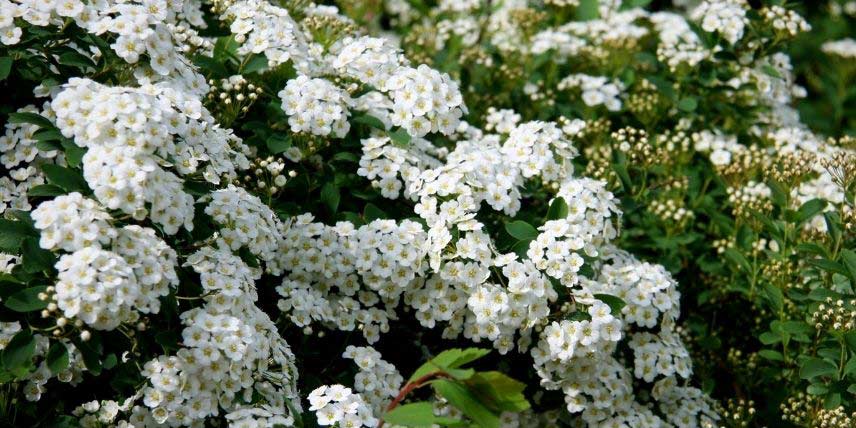
Buddleia 'White Profusion'
Buddleia ‘White Profusion’ offers from June to September/October a generous, fragrant flowering in conical panicles measuring about 40 cm long. It is a melliferous young plant whose nectar is popular with butterflies. It grows quickly and reaches up to 3 m high and 4 m across. Leaves are long and narrow, lanceolate, measuring around 20 cm in length. They are grey-green and deciduous. Buddleia ‘White Profusion’ also adapts well to container growing. It favours full sun, well-drained soil, and tolerates poor soils and drought quite well.
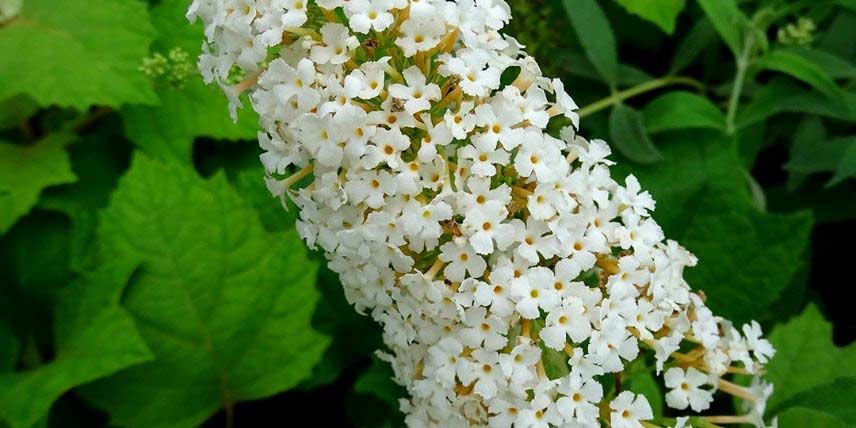
Syringa 'Madame Lemoine'
Syringa ‘Madame Lemoine’ is a superb white lilac. It produces in spring, in May, a flowering in panicles, composed of double, lightly scented flowers. It is the most beautiful of white lilacs! Its qualities earned it the Award of Garden Merit from the Royal Horticultural Society (RHS). It also bears attractive cordate, deciduous foliage. Its elegant habit, forming a small tree, reaches up to 4 m in height and 2.50 m in spread. Plant it in sun or light shade, in fresh, well-drained soil, not too acidic. It prefers slightly calcareous soil. Plant as a specimen to showcase it, but it can also be combined with other bushes such as mock oranges, viburnums, buddleias, or included in a flowering, country-style hedge.
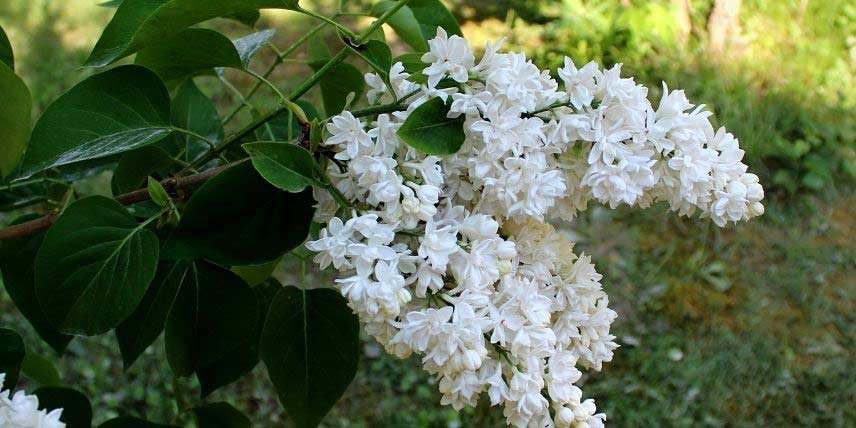
- Subscribe!
- Contents
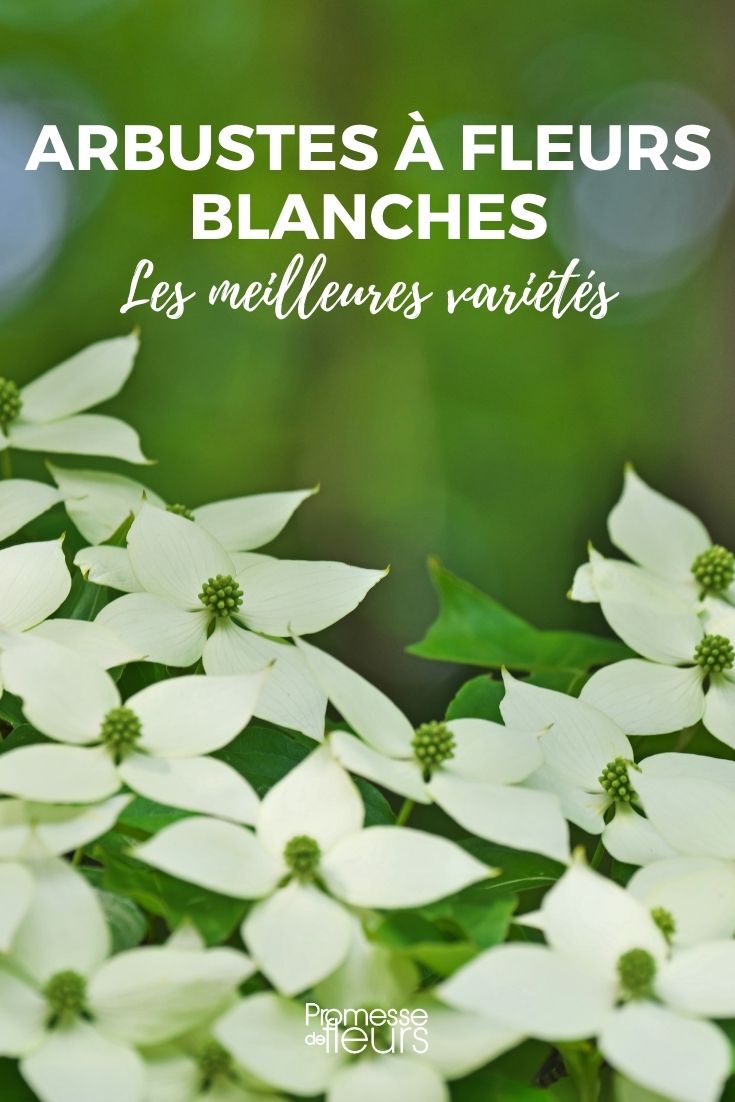



































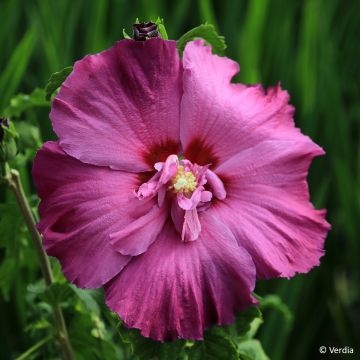
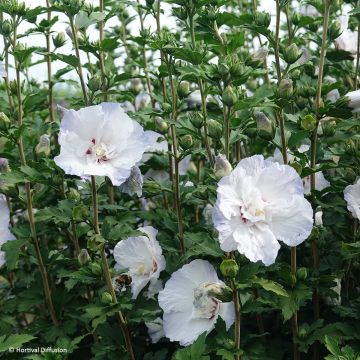


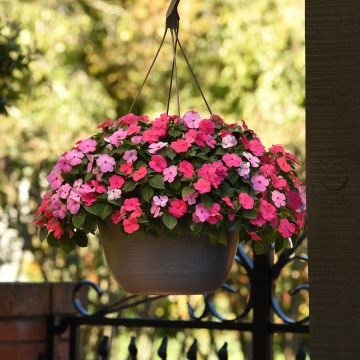
Comments